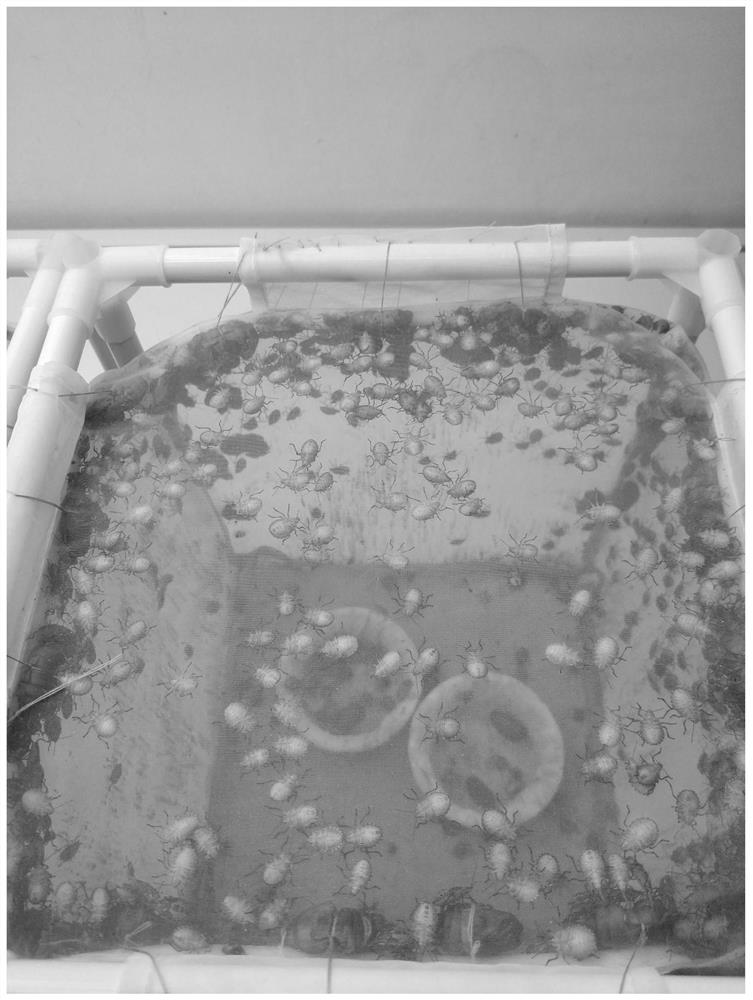Arma chinensis breeding method
A technology for cockroach and old cockroach, which is applied in the field of cockroach breeding, can solve the problems of high labor cost, waste, increase the proportion of cockroach self-mutilation, etc., and achieves the advantages of low labor input cost, less pollution by pathogenic bacteria, and increased additional output value. Effect
- Summary
- Abstract
- Description
- Claims
- Application Information
AI Technical Summary
Problems solved by technology
Method used
Image
Examples
Embodiment 1
[0033] (1) Obtain silkworm chrysalis: take mulberry leaves as food, artificially raise silkworm larvae from Changsha, Hunan in an insect-raising box, and the raising temperature is 25° C. After 4 days, pick out the healthy silkworm cocoons, cut them with scissors to pick out the healthy silkworm chrysalis, and put them in a plastic box for later use. Put the plastic box in which the silkworm chrysalis is placed in a low temperature environment for refrigerated storage. 4°C, the humidity of refrigerated storage is 40%, and the storage time is ≤60 days;
[0034] (2) Breeding of stinkbugs: put the egg-collecting cups with stinkbug eggs into an artificial climate incubator for hatching, and cover the mouth of the ovum-collecting cup with gauze, absorbent cotton for moisture retention, the temperature is 26°C, and the humidity is 68%. , photoperiod 10L:14D, hatching for 9 days; when the stinkbug eggs begin to hatch, soak the absorbent cotton with honey water with a concentration of...
Embodiment 2
[0037] (1) Obtain silkworm chrysalis: take mulberry leaves as food, artificially raise silkworm larvae from Changsha, Hunan in an insect box, and the raising temperature is 25° C. After 4 days, pick out the healthy silkworm cocoons, cut them with scissors to pick out the healthy silkworm chrysalis, and put them in a plastic box for later use. Put the plastic box in which the silkworm chrysalis is placed in a low temperature environment for refrigerated storage. 4°C, the humidity of refrigerated storage is 40%, and the storage time is ≤60 days;
[0038] (2) Breeding of stinkbugs: put the egg-collecting cups with stinkbug eggs into an artificial climate incubator for hatching, and cover the mouth of the ovum-collecting cup with gauze, absorbent cotton for moisturizing, the temperature is 27°C, and the humidity is 75%. , photoperiod 10L:14D, hatching 10 days; When the stinkbug eggs begin to hatch, soak the absorbent cotton with honey water with a concentration of 5%, and cover th...
Embodiment 3
[0041](1) Obtain silkworm chrysalis: take mulberry leaves as food, artificially raise silkworm larvae from Changsha, Hunan in an insect box, and the raising temperature is 25° C. After 4 days, pick out the healthy silkworm cocoons, cut them with scissors to pick out the healthy silkworm chrysalis, and put them in a plastic box for later use. Put the plastic box in which the silkworm chrysalis is placed in a low temperature environment for refrigerated storage. 4°C, the humidity of refrigerated storage is 40%, and the storage time is ≤60 days;
[0042] (2) Breeding of stinkbugs: Put the egg-collecting cups with stinkbug eggs into an artificial climate incubator for hatching, and cover the mouth of the ovum-collecting cup with gauze, absorbent cotton for moisture retention, the temperature is 26°C, and the humidity is 72%. , photoperiod 10L:14D, hatching for 12 days; when the stinkbug eggs begin to hatch, soak the absorbent cotton with honey water with a concentration of 5%, and...
PUM
 Login to View More
Login to View More Abstract
Description
Claims
Application Information
 Login to View More
Login to View More - R&D
- Intellectual Property
- Life Sciences
- Materials
- Tech Scout
- Unparalleled Data Quality
- Higher Quality Content
- 60% Fewer Hallucinations
Browse by: Latest US Patents, China's latest patents, Technical Efficacy Thesaurus, Application Domain, Technology Topic, Popular Technical Reports.
© 2025 PatSnap. All rights reserved.Legal|Privacy policy|Modern Slavery Act Transparency Statement|Sitemap|About US| Contact US: help@patsnap.com

